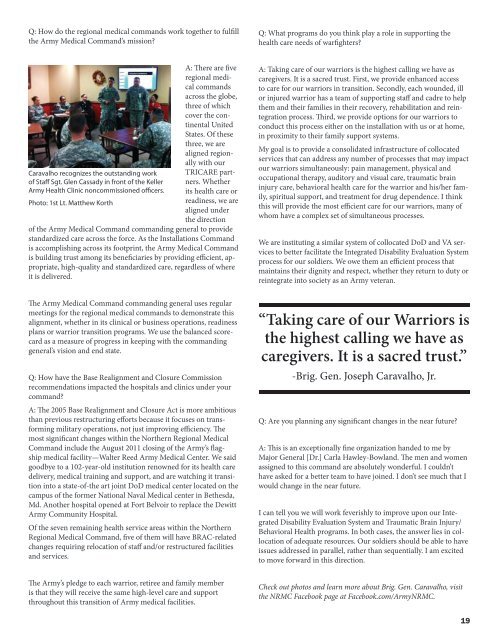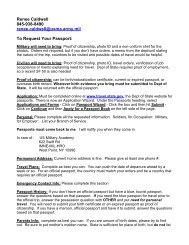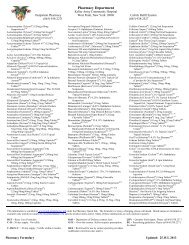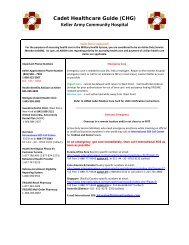North - Keller Army Community Hospital - U.S. Army
North - Keller Army Community Hospital - U.S. Army
North - Keller Army Community Hospital - U.S. Army
You also want an ePaper? Increase the reach of your titles
YUMPU automatically turns print PDFs into web optimized ePapers that Google loves.
Q: How do the regional medical commands work together to fulfillthe <strong>Army</strong> Medical Command’s mission?Q: What programs do you think play a role in supporting thehealth care needs of warfighters?Caravalho recognizes the outstanding workof Staff Sgt. Glen Cassady in front of the <strong>Keller</strong><strong>Army</strong> Health Clinic noncommissioned officers.Photo: 1st Lt. Matthew KorthA: There are fiveregional medicalcommandsacross the globe,three of whichcover the continentalUnitedStates. Of thesethree, we arealigned regionallywith ourTRICARE partners.Whetherits health care orreadiness, we arealigned underthe directionof the <strong>Army</strong> Medical Command commanding general to providestandardized care across the force. As the Installations Commandis accomplishing across its footprint, the <strong>Army</strong> Medical Commandis building trust among its beneficiaries by providing efficient, appropriate,high-quality and standardized care, regardless of whereit is delivered.A: Taking care of our warriors is the highest calling we have ascaregivers. It is a sacred trust. First, we provide enhanced accessto care for our warriors in transition. Secondly, each wounded, illor injured warrior has a team of supporting staff and cadre to helpthem and their families in their recovery, rehabilitation and reintegrationprocess. Third, we provide options for our warriors toconduct this process either on the installation with us or at home,in proximity to their family support systems.My goal is to provide a consolidated infrastructure of collocatedservices that can address any number of processes that may impactour warriors simultaneously: pain management, physical andoccupational therapy, auditory and visual care, traumatic braininjury care, behavioral health care for the warrior and his/her family,spiritual support, and treatment for drug dependence. I thinkthis will provide the most efficient care for our warriors, many ofwhom have a complex set of simultaneous processes.We are instituting a similar system of collocated DoD and VA servicesto better facilitate the Integrated Disability Evaluation Systemprocess for our soldiers. We owe them an efficient process thatmaintains their dignity and respect, whether they return to duty orreintegrate into society as an <strong>Army</strong> veteran.The <strong>Army</strong> Medical Command commanding general uses regularmeetings for the regional medical commands to demonstrate thisalignment, whether in its clinical or business operations, readinessplans or warrior transition programs. We use the balanced scorecardas a measure of progress in keeping with the commandinggeneral’s vision and end state.Q: How have the Base Realignment and Closure Commissionrecommendations impacted the hospitals and clinics under yourcommand?A: The 2005 Base Realignment and Closure Act is more ambitiousthan previous restructuring efforts because it focuses on transformingmilitary operations, not just improving efficiency. Themost significant changes within the <strong>North</strong>ern Regional MedicalCommand include the August 2011 closing of the <strong>Army</strong>’s flagshipmedical facility—Walter Reed <strong>Army</strong> Medical Center. We saidgoodbye to a 102-year-old institution renowned for its health caredelivery, medical training and support, and are watching it transitioninto a state-of-the art joint DoD medical center located on thecampus of the former National Naval Medical center in Bethesda,Md. Another hospital opened at Fort Belvoir to replace the Dewitt<strong>Army</strong> <strong>Community</strong> <strong>Hospital</strong>.Of the seven remaining health service areas within the <strong>North</strong>ernRegional Medical Command, five of them will have BRAC-relatedchanges requiring relocation of staff and/or restructured facilitiesand services.“Taking care of our Warriors isthe highest calling we have ascaregivers. It is a sacred trust.”-Brig. Gen. Joseph Caravalho, Jr.Q: Are you planning any significant changes in the near future?A: This is an exceptionally fine organization handed to me byMajor General [Dr.] Carla Hawley-Bowland. The men and womenassigned to this command are absolutely wonderful. I couldn’thave asked for a better team to have joined. I don’t see much that Iwould change in the near future.I can tell you we will work feverishly to improve upon our IntegratedDisability Evaluation System and Traumatic Brain Injury/Behavioral Health programs. In both cases, the answer lies in collocationof adequate resources. Our soldiers should be able to haveissues addressed in parallel, rather than sequentially. I am excitedto move forward in this direction.The <strong>Army</strong>’s pledge to each warrior, retiree and family memberis that they will receive the same high-level care and supportthroughout this transition of <strong>Army</strong> medical facilities.Check out photos and learn more about Brig. Gen. Caravalho, visitthe NRMC Facebook page at Facebook.com/<strong>Army</strong>NRMC.19





